Home Index
|
Home Index |
A Small Yacht Electrical System
From a small sailing yacht to a very large motor yacht the first thing one needs to decide is how much electricity is needed. After that the question of how that is going to be produced must be tackled. Only after those issues are settled should you start to consider other factors.
If you need more electricity in a period than the batteries will hold you must get flat batteries.
If you can not put sufficient electricity back into the batteries within that period you get flat batteries.
Batteries that are left in any sort of discharged condition will deteriorate much faster than fully charged ones, and batteries that are discharged very low and frequently will have a much shorter life.
Deeper technical explanations can be found on www.TB-Training.co.uk
Finding How Much Electricity Is Needed.
First you need to decide upon a "use period", on a motor cruiser this is fairly easy because if you charge your batteries every day the period will be 24 hours. However on a small yacht you may well have to have several goes at this with different assumptions before you find the right one for you. You may also find that this and the next process will alter the way you run your yacht.
I will assume 24 hours, but accept when passage making this may not be realistic. Also do the calculation for the worst case, and not the best case.
List the electrical items that will be on during the period.
This may look something like this:-
Navigation lights
Chartroom/internal lights
Bilge pump
Water pump
Navigation instruments
Ignore the starter for the moment and assume a small yacht will use manual anchor winches.
Next find the current consumed by each one. Pumps should have the amperage drawn quoted on the label, but most other things will be quoted in watts. Convert this to amps by dividing by 12 for battery driven loads and 10 for any inverter driven loads (like phone charger or GPS battery charger etc.). Do not be too accurate, but do not underestimate.
I am not sure about the regulations for lights when sailing, but I assume one white light at 21 watts
Navigation light 2 amps
Chartroom/internal lights say 4 amps
Bilge pump 3 amps
Water pump 4 amps
Navigation instruments say 1 amp
Now decide how long each will be used for in the period you choose – I am using 24 hours during the spring/autumn – and multiply the amps by hours
Navigation light 2 amps 10 hrs 20 Ah
Chartroom/internal lights say 4 amps 4 hrs 16 Ah
Bilge pump 3 amps 0.25 hrs 1 Ah
Water pump 4 amps 1 hr 4 Ah
Navigation instruments say 0.5 amp 24 hrs 12 Ah
Now add all those amp hours up. In this case we end up with 53 amp hours of electrical storage required.
Choosing Battery Capacity
For a variety of reasons, including long life, this figure needs to be virtually quadrupled which means we must install something like 212 Ah of battery capacity – say 2 X 110 Ah batteries. The type is up to you, but unless I had very beamy family cruising yacht with a good keel I doubt I would be happy with ordinary wet cells. I suspect I would use Absorbed Glass Mat (AGM) batteries as a fair compromise between cost, performance and availability. Ideally you will be using deep cycle batteries for this load, but dual purpose ones may well be more attractive because they will also start the engine without major damage.
Specifying the Charging System.
You need to put about 20% more electricity back into the battery than you took out, so during the cruising period we need to replace about 65 AH of electricity. How this is accomplished is up to you, but it may well shorten battery life if it is charged at more than about 20% of its amp hour capacity, so we should aim at a maximum charge rate of 40 amps – however it is produced.
For the moment we will only consider the engine alternator.
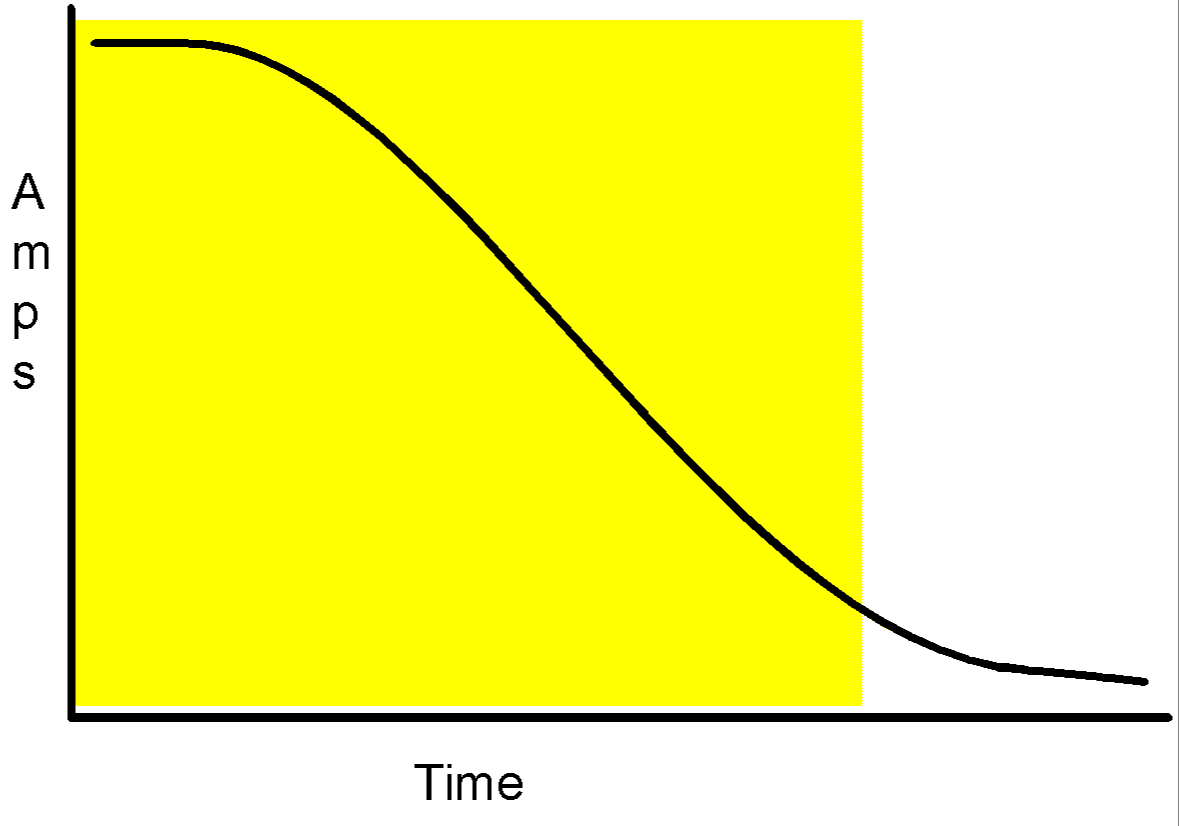
Alternator output graph © A Brooks 2005
A typical alternator output graph looks like this with a high initial output falling away to a float charge after a period of time. This makes getting any meaningful output over a period of time difficult. However if you fit an ammeter or use a clamp type ammeter on the main battery lead and note how long it takes to fall to under 10 amps you can assume the output for that period will average about 50% of what it says on the alternators label or datasheet.
All the above shows that we need a 40 amp alternator to avoid overcharging the batteries, and we need to run the engine for about. 53 divided by 20 = 2.65 hours.
If that suits your cruising style then you know how many batteries to install and the size of alternator required, however if you do not want to run for over 2.5 hours a day you must look at either shedding load, or other forms of charging like solar cells, wind generator, towed generator. Unfortunately the outputs of these devices are, shall we say, unpredictable, so are more difficult to design for.
Outboard Motor or Dynamo Charging Systems
The very low or just plain low outputs of these systems means the charging times become very long, so you might decide to shore charge and carry sufficient charged batteries to provide for the length of cruise expected. An unventilated dynamo on a petrol engine is likely to only provide about 10 amps, whilst a ventilated one will give about 28 amps at absolute maximum. Small, manually started, outboard motor battery charging systems may only give a few amps
Adding an Engine Battery
If you add another 75 Ah engine starting battery the maximum alternator output rises to virtually 60 amps with a recharge time of 1.6 hours.
This is one of the main reasons I always prefer a split charging system, as well as it ensures that a domestic battery failure does not prevent engine starting.
If you decide to simply have two banks of batteries each bank should be capable of meeting the load for the "use period" otherwise it is all too easy to end up with no battery bank capable of starting the engine – especially if it’s a small diesel.
Now, having done all those sums, you can go away and play with figures, equipment levels, engine run times etc. and come up with a specification and operating method to suit your own circumstances.
SPLIT CHARGING SYSTEMS
There is nothing magic about each battery getting the correct amount of charge on a split charging system. The current flowing to each battery will result from the DIFFERENCE between the battery voltage and the alternator output voltage. A flat battery will have a big voltage difference and so get a large charge, whilst a well charged battery will only have a little difference and so get a small charge.
The flat battery will be charged more quickly than the charged one, so eventually both arrive at a fully charged state. No electronics are needed, its basic physics.
I think simplicity is the key on a small yacht, so you have two choices:-
Big Red switch
Split Charge Relay
The diagram for the Big Red Switch used as a charge splitter is as shown on the next page
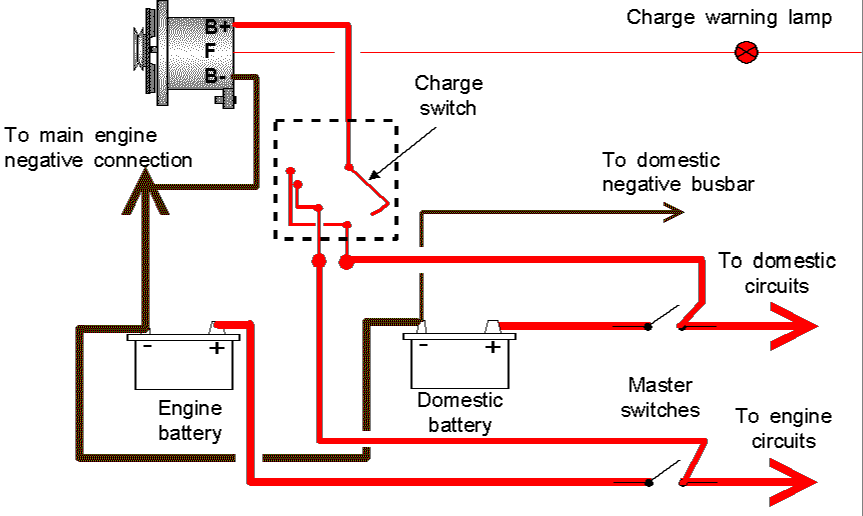
Split Charge Switch © A Brooks 2005
The big red switch can be wired so it switches either or both batteries to supply the load and also to charge, but in my view that gives too much chance to forget to switch it and flatten all the batteries.
There is also an issue if the switch partially fails and brakes its contacts before it makes them under switching. If that did happen it is likely to create a voltage spike that would damage the alternator.
The diagram for a split charge relay is shown below
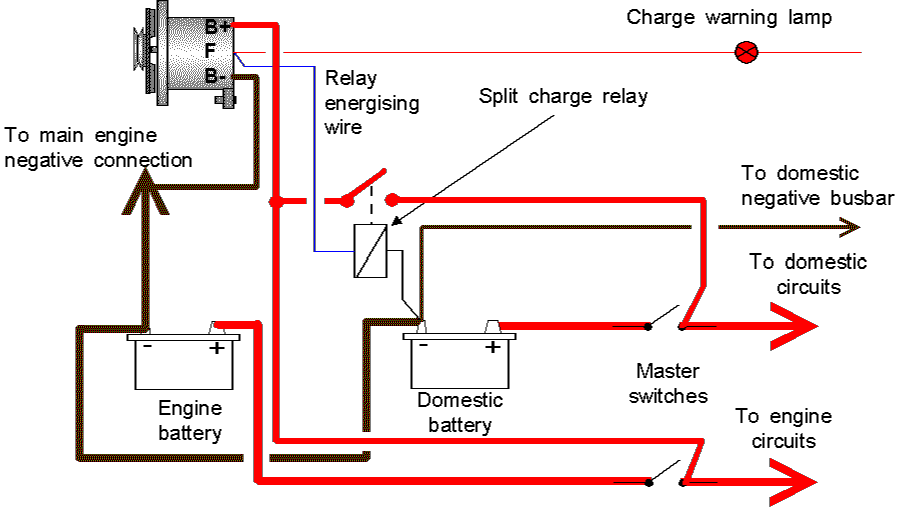
Split Charge Relay © A Brooks 2005
The thin wire from the alternator to the relay can be fed from the alternator’s auxiliary output terminal (if there is one), warning lamp terminal, or if no other way the ignition switch or rising oil pressure switch.
Master Switches
Fitting an accessible master switch is good practice because a short circuit can set fire to the boat and will not cool down until either the cable burns through or the supply is removed – switches are faster that waiting for the batteries to flatten. Just make sure you use good quality switches that are rated for at least 50% more than the starter current.
Battery master switches are mandatory under the Boat Safety Scheme.
Starter Circuits
A generic starter & charging circuit is shown below.
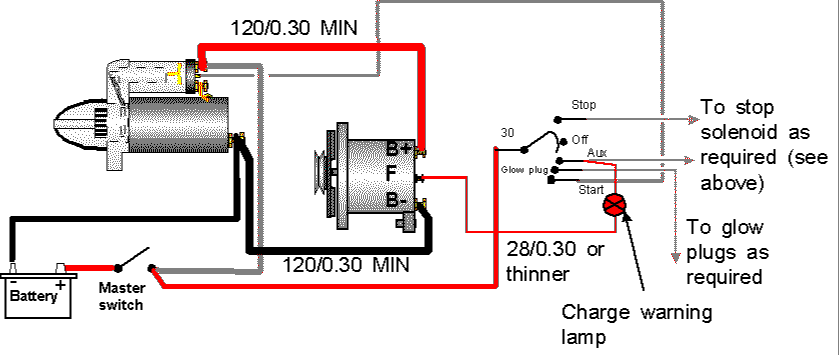
The Starting/Charging Circuit © A Brooks 2005
Do not stint on the size of the starter cables, the longer they are the thicker they need to be.
WIRING THE DOMESTIC CIRCUITS
Cable Size
First ensure the cable is large enough so you do not loose electricity by heating up small cables. The formula to use is:-

Current = amps
Length = out AND back length in metres
Area = cross section area of the conductor
Try to get less that 0.3 voltdrop, but accept 0.5 if you have to.
Excess votdrop can give similar symptoms to flat batteries when higher current loads are used.
There is no problem related to using cable that are too thick apart from your bank balance and possible routing problems.
Fuse/Circuit Breaker Selection
The fuse or circuit breaker is there to protect the CABLES – not the appliance – so NEVER fit a fuse or circuit breaker rated at more than the cables capacity.
Wiring the Circuits
A typical domestic and instrument circuit diagram is shown below.
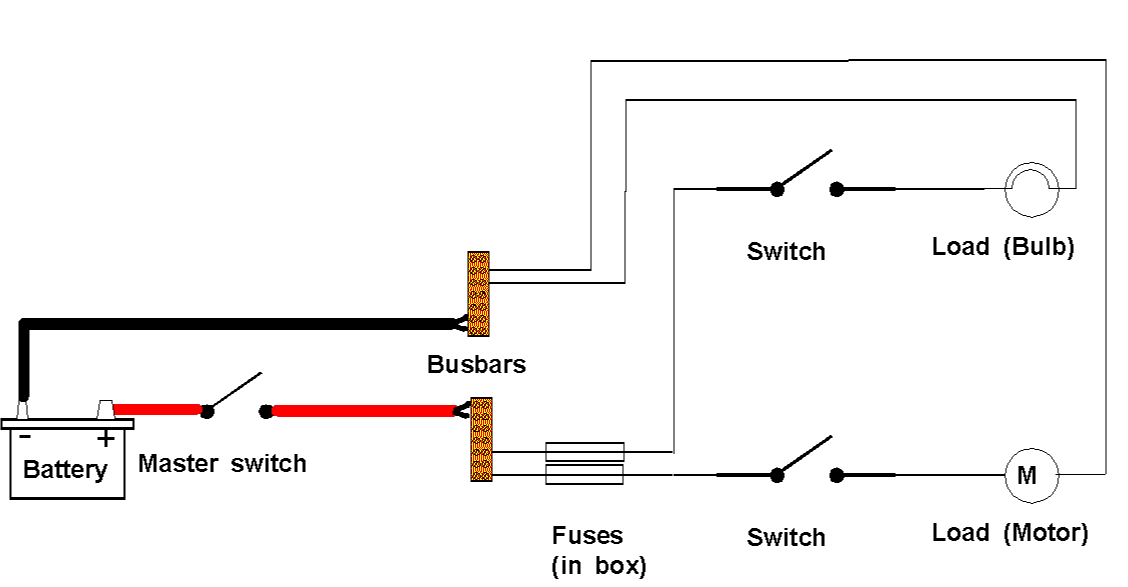
A typical domestic/instrument circuit © A Brooks 2005
You can add more circuits, fusing each, from the busbars, but you must ensure that the cables supplying the busbars are large enough. Good practice is to fit a single large fuse close to the master switch, but this is rarely done on small craft.
For things like internal lights you can "T" off the positive and negative cables to supply more lights from one fuse, but the fuse must never exceed the cable’s current rating.
Other items like Navigation lights will be "T"d off from the switch, so one switch controls more than one light.
END PIECE
I trust this gives you some help in understanding and possibly wiring your boat. Much fuller information may be found on www.TB-training.co.uk . There you will also find information on mechanical boat maintenance topics and details of an email advice service.
Tony Brooks Tec. Eng. MIRTE MSOE
|
Home Index |